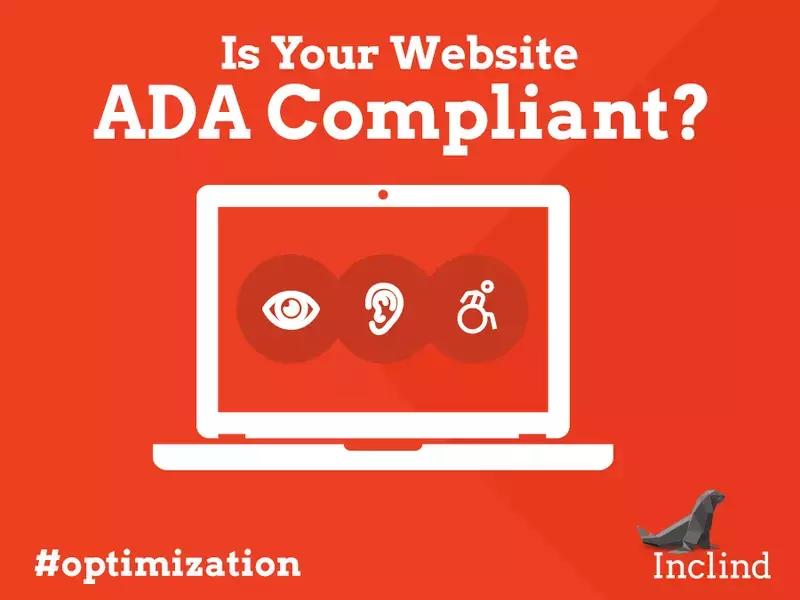A healthy website is an optimized website. Optimization is not just about top search engine results, it takes into consideration a website’s overall performance. An optimized website gives users a positive experience and gets you better search engine placement. One way to optimize your website is to make sure your website is ADA compliant. What does this mean? Let’s dive in.
Here’s a History Lesson
Likely you are familiar with the American with Disabilities Act (ADA), a law enacted in 1990 that guarantees that people with disabilities have the same opportunities as everyone else to participate in the mainstream of American life.
Consequently, in 1990, Tim Berners-Lee, the inventor of the Internet, was writing the first HTML source code. The world wide web was in infancy.
As the web evolved, only government or public use websites were required to be what is called “Section 508 compliant,” in accordance with the Rehabilitation Act of 1973,amended in 1978, federal agencies were required to make their electronic and information technology (EIT) accessible to people with disabilities — mainly the vision or hearing impaired.
Today’s Standards
From Facebook and Instagram, to online banking and online grocery shopping — the web is an integral part of our day-to-day lives. Because of that, a ruling was passed requiring website accessibility through ADA Title III stating that public accommodations comply with ADA standards. The expectations of websites to be usable by those with disabilities are no longer just a requirement of .govs and .orgs. Every website should be accessible by all.
What Makes a Website Compliant?
In 2008, the World Wide Web Consortium created the Web Content Accessibility Guidelines (WCAG) which provides the four guiding principles of accessible websites: perceivable, operable, understandable and robust. These are basically principles of good user experience design. In other words, things that make your website better anyway.
Here’s the quick breakdown of the four principals:
Perceivable- Make sure your alt tags are populated.
- Caption audio and video content.
- Use a CAPTCHA with an audio option.
- Use color contrast to separate foreground from background.
Operable- Make the website functional from a keyboard. A good example of this is if there is a click and drag feature on your website, be sure that there is a way this can be done with arrow keys.
- Provide users enough time to read and use content. If you have carousels and sliders, be sure that appropriate time is given to read the words before transitions.
- Do not design content in a way that is known to cause seizures. Watch those animated gifs.
- Make sure your users know how to get around your website with easy navigation, visual cues and breadcrumb navigation.
Understandable
- Keep your content at a simple and conversational at lower secondary reading level (think 9th-11th grade). Avoid complex jargon or undefined acronyms.
- Have your website work in expected ways, drawing on interactions that are already familiar to the user.
- Make it easy to avoid mistakes or correct them.
Robust
-Make sure your website is compatible with current and future assistive technologies. Good code is key here.
How Accessibility is Measured
There are three levels of compliance: A, AA, AAA with A being the most basic. As of January 2018, websites are expected to be at least level A compliant.
For government organizations and public use websites, the highest level of compliance (AAA) is necessary, but, for business websites, reaching the AA level is ideal for accessibility and optimization. A is okay but we recommend aiming higher.
What if Your Website Isn’t Compliant?
As of January 2018, all websites are expected to be level A compliant or you could get hit with a lawsuit by the Department of Justice (DOJ). Major brands have gotten called out by the DOJ for non-compliance.
You may also lose rank in the SEO game or find it harder to gain rankings without having an ADA compliant website. And having a compliant website creates a better experience for every user.
How Do I Make My Website ADA Compliant?
There are free tools available to help you determine if your website is compliant. If there are lots of errors, you can work to make sure changes are implemented to bring your website up to par which could be something as simple as populating alt tags or adjusting color contrast on buttons.
Depending on the tool, the results may be difficult to interpret, so it may be useful to turn to your web developer to help you make sense of results and implement improvements to get you to an optimized level.
Want to find out more about how to optimize your website and assess its accessibility? Contact us today for a free ADA compliance review.
Unearth Our Day Hikes
Information Request
Please fill out the information below.
Schedule A Meeting
Please fill out the information below.
Schedule a Phone Call
Please fill out the information below.
Information Request
Please fill out the information below.
Submit a Request or RFP
Please fill out the information below.
